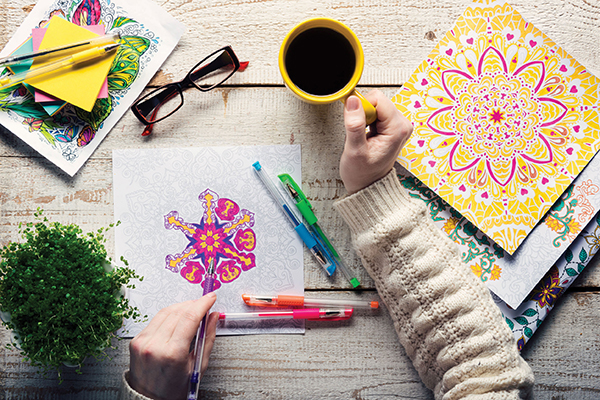Just Relax
Using Active Relaxation Techniques to Help You Stay Calm during Cancer
by Dawn McDougal Miller, MME, MT-BC
Do you find it difficult to relax or meditate? Instead of effortlessly easing into a blissful meditative state, do random thoughts continually pop into your head? Or maybe your list of “Things I Need to Do” plays on a looping scroll across your mind? When someone says to you, “Just relax,” do you sometimes want to scream that this advice is impossible to follow? Do you ever feel frustrated because it seems as if everyone around you has blissfully achieved Zen while you continue to struggle?
If any of this sounds familiar, let me assure you that you are not alone. Many people struggle with quieting their mind and finding stillness, especially people who are going through cancer. Let’s face it, the whole experience is riddled with anxiety triggers. However, there are some things you can do to help yourself relax – or even meditate – as you take this journey.
The methods I will describe here are called active relaxation techniques. Some of them you can do at your cancer center while you’re undergoing chemotherapy. Others you can do at home. I encourage you to give several of them a try so you can see which strategies work best for you.
During Chemotherapy
Here are some examples of active relaxation techniques you can use while you are at a cancer treatment center undergoing chemotherapy:
- Play a musical instrument that doesn’t require much musical ability. For example, drums, rain stick, ocean drum, singing bowl, Reverie Harp, finger chimes, or other percussion instruments. Playing these types of instruments repetitively and tuning in to the sounds you are making can be quite relaxing. To further explore this technique, check to see if your hospital or cancer treatment center has a music therapist who can introduce you to additional musical resources, music-assisted relaxation, or other music therapy techniques.
- Knit or crochet a simple repetitive pattern that doesn’t require much active thinking or attention.
- Trace a finger labyrinth with a pencil or your finger. A finger labyrinth is a small labyrinth, often made out of paper, wood, or metal, that has a pattern with an opening on the outside and a path that leads to the center and then back out again. See how slowly you can move your finger as you trace the pattern. You may want to set an intention – such as peace, healing, or stillness – before you begin. When your finger arrives at the center of the labyrinth, pause for a moment, take some deep breaths, and breathe in this intention before tracing the pattern back to the outside.
- Color in an adult coloring book. There are so many different options with interesting patterns, designs, images, and landscapes that you’re sure to find something that appeals to you. As an added treat, consider buying yourself a new box of colored pencils or markers for this activity.
- Draw to music. (See exercise at the end for a simple how-to.)
At Home
Here are some examples of active relaxation techniques you can use at home:
- Sit or walk in nature while focusing on the sights, smells, and sounds around you. Notice how your body relaxes as you focus on a gentle breeze blowing across your face, a cool mist on your skin, or the warm sunlight soaking into your muscles.
- Practice walking meditations. Walk slowly, paying attention to one footstep at a time. Focus entirely on the slow movements of your footsteps and how your feet connect with the ground beneath you.
- Pet a dog, cat, or another furry, friendly animal. Listening to a cat purr or seeing a dog wag its tail can be both mesmerizing and comforting.
- Work on art or craft projects that don’t require much cognitive thinking. Some examples are collages, watercolors, and finger painting.
Final Note
You don’t have to be an expert at meditation to reap the benefits of these active relaxation practices. Practicing these techniques before or during chemotherapy can be a wonderful tool to help decrease anxiety. Doing them on a regular basis can help you focus on healing by giving you an active way to quiet your mind.
MUSIC AND DRAWING: An Active Relaxation Exercise
Drawing to music is a worthwhile active relaxation technique that you can use anywhere. And, no, you don’t have to be an artist to use this technique. Just follow these simple steps:
1. On a table or tray in front of you, set up a piece of art paper, along with a set of oil pastels, crayons, or colored pencils.
2. Select a piece of music that appeals to you, inspires creativity, or helps you relax. Prepare to play the music on headphones if you are in a public space, or through a speaker if you are in private. Set the music up to repeat automatically. Here are some selections you may want to try:
- “Prelude to an Afternoon of a Faun” by Debussy
- “Canon in D” by Pachelbel
- “Air on a G String” by Bach
- “Rhosymedre” by Vaughan Williams (orchestral)
- Clarinet Concerto in A, K622: 2 “Adagio” by Mozart
- Carmen Suite No. 1 “Intermezzo” by Bizet
- “Introduction and Allegro” by Ravel
These music suggestions are from the classical music genre and they will not sound like the relaxing music you might hear at a spa. Classical music has more changes, movement, and a variety of instruments and sounds, which facilitate creativity and the drawing process.
3. Take a few moments to relax and take some deep breaths. You may want to close your eyes or soften your gaze. As you take those deep breaths, allow yourself to begin to clear your mind as much as possible. With your eyes still closed, invite in colors, shapes, patterns, or movements that appeal to you today.
4. Open your eyes and look at the colors of the oil pastels or crayons in front of you. What colors are calling out to you? Take these out of the container.
5. Start your music, and begin to draw with the music. Move the oil pastels or crayons that you select across the paper in time to the music. Can you move your drawing utensil across the paper with the sounds and movements you hear in the music?
6. Notice the shapes and patterns created in your initial drawing process. You may want to fill in those shapes with other colors when you are ready.
7. Continue drawing until the experience feels complete. This exercise could last anywhere from 5 to 20 minutes.
8. Take a moment to notice how you feel. Do you feel more relaxed, peaceful, or creative? Were you able to slow your train of thought, or even stop thinking for a few minutes during this exercise? How does your body feel? Did your muscle tension ease up, or did you notice that your breathing may have slowed down? All of these are wonderful benefits of a relaxation practice.
Additional Ideas to Try:
- Close your eyes or soften your gaze as you draw. Your goal is not to draw a pretty picture; you are drawing to relax. Most likely, you will be drawing shapes, patterns, and movements, rather than specific images. Allow yourself to focus on the process of drawing and not the product you are creating.
- Draw with your non-dominant hand. Drawing with your non-dominant hand can help you access more of your emotions and decrease cognitive thinking. It also prevents you from trying to draw the perfect pretty picture. However, if drawing with your non-dominant hand causes you to become stressed or frustrated, don’t use this variation.

Dawn Miller is a board-certified music therapist and the music therapy internship program manager at the Park Nicollet Frauenshuh Cancer Center in Minneapolis, MN. She is also a Fellow in the Association for Music and Imagery, having completed advanced training in the Bonny Method of Guided Imagery and Music. During her 33 years as a music therapist, Dawn has created several music therapy positions in hospitals and hospice programs throughout the Twin Cities.
This article was published in Coping® with Cancer magazine, September/October 2019.


